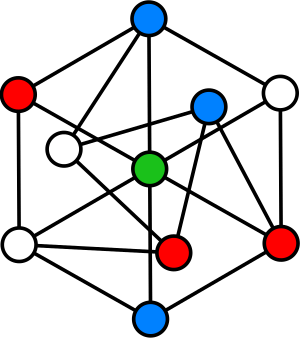Graph coloring facts for kids
Graph coloring is a fun and important topic in graph theory. Imagine you have a bunch of dots connected by lines. Graph coloring is all about giving colors to these dots, but with some special rules. The main rule is usually that any two dots connected by a line must have different colors.
The dots are called vertices and the lines connecting them are called edges. One common challenge in graph coloring is to find the smallest number of colors you need to color all the vertices without breaking the rule. This smallest number is known as the chromatic number of the graph.
Contents
What is a Graph?
In math, a graph is a way to show how things are connected. It's made of two main parts:
- Vertices: These are the "dots" or points in the graph. Think of them as places or items.
- Edges: These are the "lines" that connect the vertices. They show a relationship or connection between the items.
For example, you could use a graph to show friends on a social network. Each person would be a vertex, and an edge would connect two people who are friends.
Why Do We Color Graphs?
Graph coloring might sound like a game, but it's used to solve many real-world problems. It helps us organize things and avoid conflicts.
Solving Scheduling Puzzles
Imagine you have many events that need to happen, but some events can't happen at the same time.
- Each event can be a vertex.
- If two events can't happen at the same time, draw an edge between their vertices.
- Now, "color" each event (vertex) with a time slot. If two events are connected, they must have different time slots (colors).
- The smallest number of colors (time slots) tells you the shortest time needed to schedule everything.
Making Maps and Sudoku
Graph coloring can also help with things like making maps. When you color a map, countries that share a border must have different colors. This is a classic graph coloring problem! Each country is a vertex, and if two countries share a border, there's an edge between them.
It can even help with puzzles like Sudoku. Each square in a Sudoku grid can be a vertex. The rules of Sudoku (numbers in rows, columns, and blocks must be unique) create connections (edges) between these vertices. Finding a solution to Sudoku is like coloring the graph with numbers instead of colors.
Chromatic Number: The Fewest Colors
The most common goal in graph coloring is to find the chromatic number. This is the absolute minimum number of colors you need to color a graph so that no two connected vertices have the same color.
Finding the chromatic number for very large graphs can be quite difficult. It's a type of problem that computers find hard to solve quickly, especially as the graph gets bigger.
Images for kids
See also
 In Spanish: Coloración de grafos para niños
In Spanish: Coloración de grafos para niños


